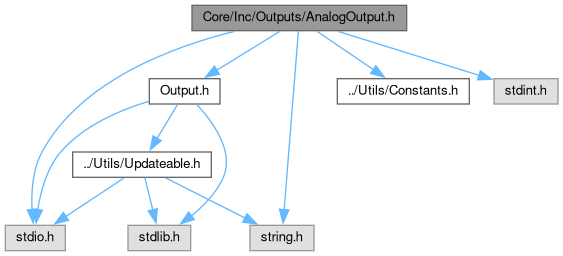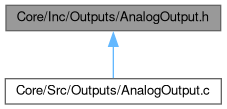#include "Output.h"#include "../Utils/Constants.h"#include <stdio.h>#include <string.h>#include <stdint.h>
Include dependency graph for AnalogOutput.h:

This graph shows which files directly or indirectly include this file:

Go to the source code of this file.
Classes | |
| struct | AnalogOutput |
Macros | |
| #define | TORQUE_LOW_MARGIN 2.0 |
Functions | |
| void | initAnalogOutput (AnalogOutput *analogoutput, const char *name, int hz, int channel) |
| Initializes an analog output. More... | |
| int | writeAnalogOutputData (AnalogOutput *output, float data) |
| Writes data to the analog output. More... | |
Variables | |
| uint32_t | dac1_buffer [DAC1_BUFFER_SIZE] |
| uint32_t | dac2_buffer [DAC2_BUFFER_SIZE] |
Macro Definition Documentation
◆ TORQUE_LOW_MARGIN
| #define TORQUE_LOW_MARGIN 2.0 |
Function Documentation
◆ initAnalogOutput()
| void initAnalogOutput | ( | AnalogOutput * | analogoutput, |
| const char * | name, | ||
| int | hz, | ||
| int | channel | ||
| ) |
Initializes an analog output.
- Parameters
-
output Pointer to the AnalogOutput structure to initialize name Name of the output (string) hz Sampling frequency in Hertz channel ADC channel number for the output (0-16)
This function initializes the base output properties, sets the ADC channel, and configures the corresponding GPIO pin based on the channel number.
Definition at line 11 of file AnalogOutput.c.
11 {
13 analogOutput->channel = channel;
14 analogOutput->buffer_index = 0;
15}
void initOutput(Output *output, const char *name, int hz, OutputType type)
Initializes an output with the given parameters.
Definition: Output.c:4
Here is the call graph for this function:

◆ writeAnalogOutputData()
| int writeAnalogOutputData | ( | AnalogOutput * | output, |
| float | data | ||
| ) |
Writes data to the analog output.
- Parameters
-
output Pointer to the AnalogOutput structure. data Data to write to the output.
- Returns
- int _SUCCESS or _FAILURE.
Definition at line 17 of file AnalogOutput.c.
17 {
18 #ifdef DEBUGn
20 #endif
21
23 // Write data to DAC1
27 // Write data to DAC2
30 } else {
31
32 #ifdef DEBUGn
34 #endif
35
37 }
39}
Variable Documentation
◆ dac1_buffer
|
extern |
◆ dac2_buffer
|
extern |